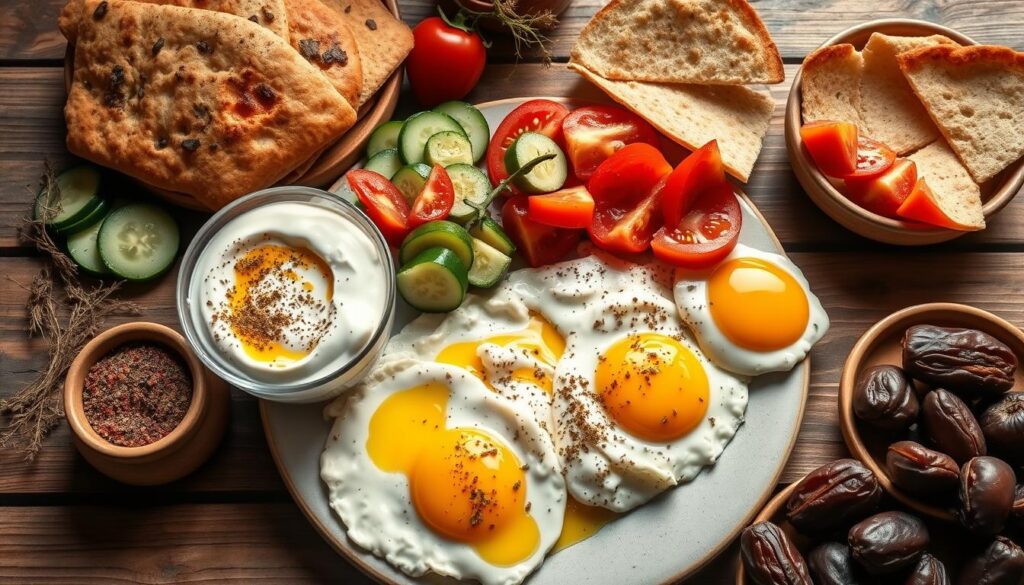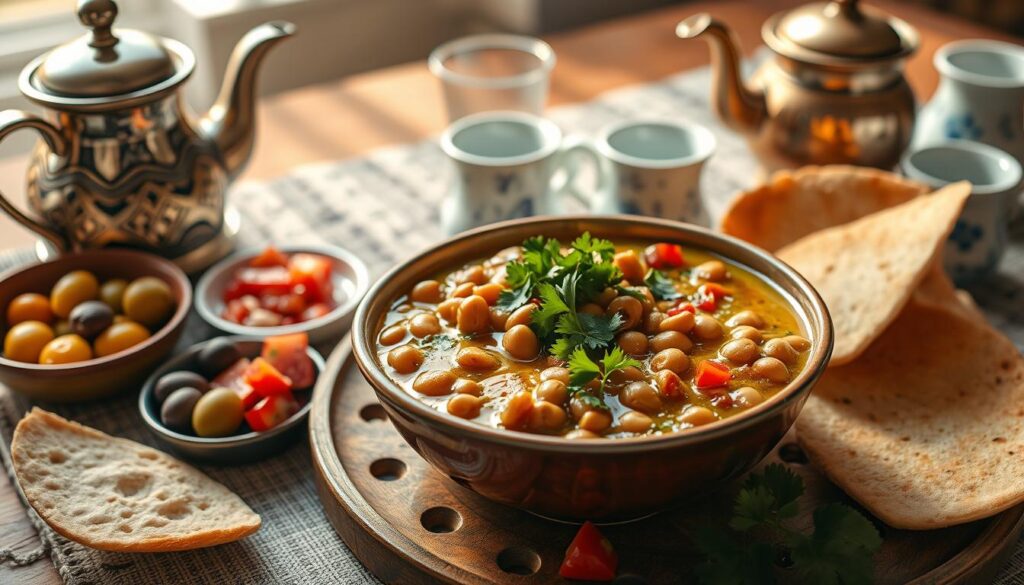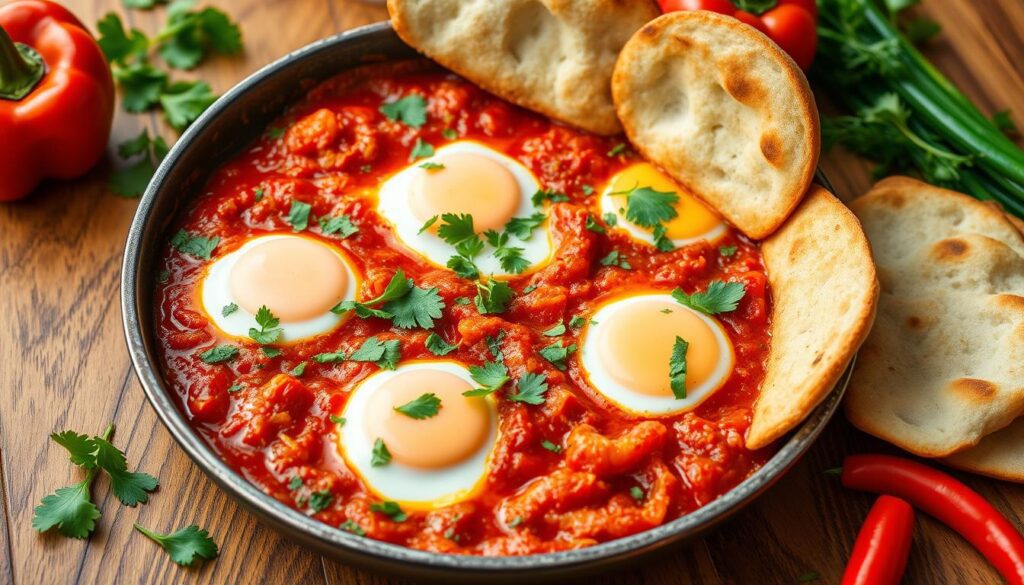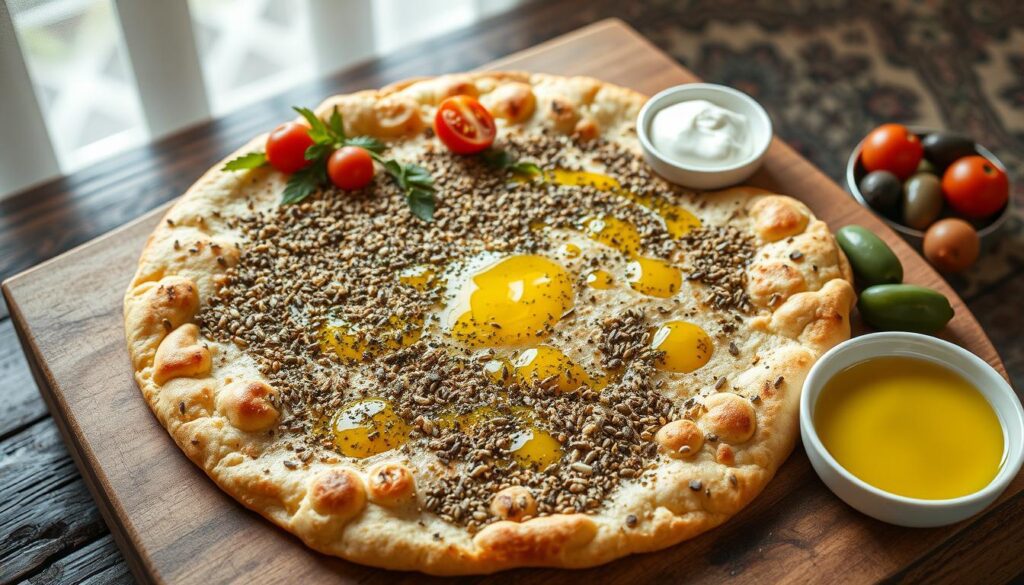Imagine waking up to a table filled with vibrant colors and intoxicating aromas. Arabic breakfast recipes are more than meals. They’re a journey through culture, family, and hospitality that makes your morning special.
Middle Eastern breakfast is not just a quick bite. It’s a celebration of fresh ingredients and the warmth of shared moments. From Cairo’s bustling streets to Damascus’ serene kitchens, each region adds its unique flavor to the morning table.
These authentic arabic breakfast recipes show the incredible diversity of Middle Eastern breakfast traditions. We’ll explore five mouthwatering dishes that take you to the Mediterranean coastlines and warm desert mornings. They reveal the heart of a cuisine that nourishes both body and soul.
Key Takeaways
- Arabic breakfasts emphasize fresh, nutritious ingredients
- Meals are a communal experience celebrating family connections
- Each region offers unique flavor profiles and ingredients
- Dishes blend nutritional value with rich cultural heritage
- Vegetarian and protein-rich options are abundant
Understanding the Culture of Arabic Breakfast Traditions
Arabic breakfasts are more than just food. They are about family, culture, and enjoying every moment. When you try lebanese breakfast food, you’ll see how it brings people together.

Arabic breakfasts focus on family and friends. They are slow and full of joy. Lebanese breakfasts are known for their variety, making everyone want to share and talk.
The Social Significance of Morning Meals
Breakfast in Arabic culture is special. It’s a time for families to come together. They share stories, laugh, and strengthen their bonds over delicious food.
- Catching up with family members
- Discussing daily plans
- Sharing stories and laughter
- Maintaining generational traditions
Regional Variations Across the Middle East
Arabic breakfasts vary by region. From Yemen’s Masoob to the Levantine za’atar manouche, each place has its own flavor. This shows the Middle East’s rich cultural diversity.
Traditional Serving Customs and Etiquette
Lebanese breakfasts have their own way of serving. Meals are shared, with many dishes on the table. Guests are encouraged to try everything, showing respect and enjoying the meal.
- Use bread to scoop shared dishes
- Accept offerings graciously
- Start with lighter items before heavier foods
- Engage in conversation during the meal
These traditions make breakfast a celebration of culture and connection.
Essential Ingredients for Arabic Breakfast Food Recipes

Exploring arabic breakfast food recipes means knowing the key ingredients. Middle eastern breakfasts use fresh, vibrant parts to make meals special.
An authentic arabic breakfast relies on a few important ingredients. They add great flavor and health benefits:
- Flatbreads: Fresh pita and markook are essential staples
- Dairy Products: Creamy labneh and white cheeses provide richness
- Herbs and Spices: Za’atar and sumac add distinctive aromatic profiles
- Olive Products: High-quality olive oil and fresh olives enhance every dish
These ingredients make your middle eastern breakfast come to life. Legumes, whole grains, and fresh produce are key for a balanced, healthy start to the day.
| Ingredient Category | Key Components | Flavor Profile |
|---|---|---|
| Breads | Pita, Markook | Soft, Neutral |
| Dairy | Labneh, White Cheese | Creamy, Tangy |
| Herbs/Spices | Za’atar, Sumac | Aromatic, Zesty |
| Sweet Components | Dates, Honey | Rich, Natural Sweetness |
Using these ingredients turns your breakfast into something amazing. It captures the heart of arabic cooking.
Foul Medames: The King of Arabic Breakfast
Discover the heart of Arabic breakfast food recipes with foul medames. It’s a beloved dish in the Middle East. This vegetarian breakfast staple turns simple fava beans into a nutritious and delicious morning meal.

Traditional Preparation Methods
Creating authentic foul medames is an art. It requires patience and the right ingredients. The traditional method involves:
- Soaking dried fava beans overnight
- Slow-cooking beans for approximately 1 hour
- Crushing garlic and mixing with olive oil
- Adding fresh lemon juice for brightness
Nutritional Powerhouse
Your breakfast will be packed with nutrition from foul medames. A single serving offers:
- 127 calories
- 12g protein
- 14g total fat
- 2g saturated fat
- 0.3g fiber
Regional Variations and Toppings
Every region adds its unique touch to arabic breakfast food recipes. Explore different foul medames styles with these popular toppings:
- Egyptian Style: Fresh tomatoes and parsley
- Lebanese Twist: Cumin and olive oil drizzle
- Damascus Variation: Radishes and chopped onions
Serve your foul medames with warm pita bread. Enjoy a breakfast that connects you to centuries of culinary tradition.
Shakshuka: A Hearty Morning Delight

Shakshuka is a vibrant, hearty breakfast from the Middle East. It turns simple ingredients into a masterpiece. This dish comes from North Africa and is loved worldwide.
Shakshuka is a one-skillet wonder. It poaches eggs in a rich tomato sauce. The main ingredients are:
- Fresh tomatoes
- Onions
- Bell peppers
- Garlic
- Eggs
The dish’s magic is in its simplicity and flavor. Spices like paprika, cumin, and chili powder add warmth. This makes shakshuka a standout breakfast.
| Nutritional Content (Per Serving) | Amount |
|---|---|
| Calories | 146 kcal |
| Protein | 7g |
| Carbohydrates | 10g |
| Total Fat | 9g |
To make shakshuka, cook veggies until soft. Add spices, then crack eggs into the sauce. It cooks in 20-30 minutes, making it quick and fulfilling.
Enjoy shakshuka straight from the skillet. Serve with crusty bread or warm pita. Add fresh herbs like parsley or cilantro for extra flavor and beauty.
Manakish: The Middle Eastern Breakfast Pizza
Manakish is a favorite Lebanese breakfast food. It’s at the heart of Middle Eastern cooking. This tasty flatbread turns simple ingredients into a wonderful morning meal.

Making manakish is an art that’s been passed down for generations. It takes skill and love to make this ordinary flatbread into something special.
Za’atar and Cheese Variations
Manakish comes in two delicious flavors:
- Za’atar Manakish: A mix of dried herbs, sesame seeds, and olive oil on the dough
- Cheese Manakish: Topped with creamy Akkawi or Nabulsi cheese
Dough Making Tips
To make perfect manakish, pay close attention to the dough. Here are some important tips:
| Ingredient | Quantity | Notes |
|---|---|---|
| Bread Flour | 1 ½ cups | Creates ideal texture |
| All-Purpose Flour | 1 ½ cups | Provides additional structure |
| Instant Yeast | 1 tablespoon | Helps dough rise |
| Warm Water | 105°F | Activates yeast effectively |
Serving and Storage
You can enjoy manakish in many ways. Bake it at 500°F for 5-6 minutes for a golden crust. To reheat from frozen, use an air fryer or oven at 300°F for 5-10 minutes.
Manakish is great for any meal. Try it with fresh veggies or yogurt for a full meal.
Labneh and Fresh Accompaniments
Labneh is a key part of Lebanese breakfasts. It turns your morning into a tasty adventure. This yogurt cheese is tangy and rich, making simple spreads more exciting.
Making labneh is easy. You need whole milk yogurt, cheesecloth, and patience. Strain the yogurt to get a thick, creamy cheese with a smooth feel.
Homemade Labneh: Step-by-Step Guide
- Line a fine mesh sieve with cheesecloth
- Add 32 oz of whole milk yogurt
- Sprinkle ¼ to ½ tsp of salt
- Tie the cheesecloth and place a weight on top
- Refrigerate for 24-36 hours
Nutritional Powerhouse
Labneh is not just tasty; it’s also full of protein and probiotics. Each serving has over 25 grams of protein. It’s a great choice for those who care about their health.
Serving Suggestions
| Topping | Flavor Profile |
|---|---|
| Olive Oil | Rich, smooth |
| Za’atar Spice | Herbal, aromatic |
| Fresh Herbs | Bright, fresh |
Enjoy labneh with fresh cucumbers, tomatoes, and olive oil for a true Lebanese breakfast. You can put it on toast, use it as a dip, or savor it alone. It celebrates Middle Eastern food traditions.
The Art of Arabic Breakfast Presentation
Arabic breakfast is more than just a meal. It’s a vibrant cultural experience that turns dining into a social celebration. Creating an authentic middle eastern breakfast involves thoughtful presentation that invites connection and conversation.
Presenting arabic breakfast food recipes requires attention to detail and cultural understanding. Your table becomes a canvas where flavors, colors, and traditions merge beautifully.
Table Setting Guidelines
When setting up your Arabic breakfast spread, consider these essential elements:
- Use large communal platters for shared dishes
- Place smaller individual plates around the central serving area
- Arrange utensils strategically for easy access
- Create visual balance with varied dish heights
Arrangement Tips for Multiple Dishes
A successful middle eastern breakfast presentation follows specific principles:
- Group similar items together
- Create color contrasts between dishes
- Use traditional ceramic or copper serving vessels
- Leave enough space between dishes for easy serving
Garnishing Techniques
Transform your arabic breakfast food recipes with professional garnishing:
| Garnish Type | Recommended Use |
|---|---|
| Fresh Herbs | Sprinkle parsley, mint, or cilantro on eggs and dips |
| Spice Blends | Dust za’atar or sumac over breads and vegetables |
| Olive Oil Drizzle | Add richness and shine to multiple dishes |
Remember, presentation is an art that transforms a simple meal into a memorable experience.
Common Mistakes to Avoid When Preparing Arabic Breakfast
Mastering Arabic breakfast recipes needs focus and knowledge of old ways. Whether you’re trying Lebanese breakfast ideas or classic dishes, many mistakes can ruin your meal’s taste.
Arabic breakfast prep is more than just a recipe. Here are key mistakes to avoid:
- Using low-quality or stale ingredients that diminish the dish’s flavor profile
- Rushing preparation processes that require patience and precision
- Neglecting proper seasoning techniques unique to Arabic cuisine
- Ignoring traditional cooking methods that define the dish’s character
Choosing the right ingredients is key for authentic Arabic breakfasts. Fresh produce, high-quality dairy, and carefully sourced spices are essential for memorable dishes.
| Common Mistake | Recommended Solution |
|---|---|
| Over-salting dishes | Use sea salt sparingly, taste as you cook |
| Incorrect bread texture | Practice traditional flatbread techniques |
| Improper labneh consistency | Strain yogurt for 12-24 hours |
| Rushed shakshuka preparation | Cook eggs slowly, maintain sauce consistency |
When trying Lebanese breakfast ideas, remember presentation is key. Arabic breakfasts are a family affair, with 3-5 dishes shared. Preparing with patience and respect for traditions will make your mornings special.
By avoiding these mistakes, you’ll make breakfast dishes that truly show Arabic culinary culture.
Beverage Pairings for Your Arabic Morning Spread
Your middle eastern breakfast isn’t complete without the right drink. Arabic morning drinks are rich and flavorful, unlike Western ones. They match the vibrant Lebanese breakfast food perfectly.
Tea is a big deal in Arabic breakfasts. Sweet mint tea is the favorite, refreshing the palate. It’s made by brewing fresh mint with black tea and adding sugar for a sweet aroma.
Popular Beverage Options
- Sweet Mint Tea – The quintessential Arabic morning drink
- Turkish Coffee – Served after breakfast in small demitasse cups
- Herbal Infusions
- Sage Tea
- Chamomile Tea
- Hibiscus (Karkadeh) Tea
- Fresh Fruit Juices
- Qamar El-Din (Apricot Juice)
- Orange Juice
Turkish coffee is a bold choice for a morning drink. It’s like espresso, served in tiny cups with sugar. The coffee is ground finely and boiled with water, making it very intense.
| Beverage | Flavor Profile | Typical Serving Style |
|---|---|---|
| Mint Tea | Sweet, Refreshing | Hot, in glass cups |
| Turkish Coffee | Strong, Rich | Small demitasse cups |
| Hibiscus Tea | Tart, Fruity | Hot or cold |
When planning your Arabic breakfast, pair drinks with dishes. Light teas like herbal ones go well with eggs, like shakshuka. Strong coffees are best with protein-rich foods like ful medames.
Making Arabic Breakfast Ahead: Tips and Storage
Preparing arabic breakfast food recipes in advance can change your morning routine. With smart meal prep strategies, you can enjoy delicious lebanese breakfast ideas without spending hours in the kitchen every day.
Streamlining your breakfast preparation requires thoughtful planning and smart storage techniques. The right approach can help you maintain the authentic flavors of traditional Middle Eastern morning meals.
Meal Prep Strategies
- Prepare dough for Manakish 1-2 days in advance
- Batch-cook Foul Medames and store in portioned containers
- Chop vegetables for Shakshuka the night before
- Make Labneh and other dips up to 4 days ahead
Smart Storage Solutions
Proper storage is key for keeping your arabic breakfast food recipes fresh. Use airtight containers and follow these guidelines:
- Refrigerate most prepared dishes for up to 4 days
- Store dips like hummus in sealed containers
- Keep flatbreads wrapped in kitchen towels
- Separate wet and dry ingredients to prevent sogginess
Reheating Guidelines
Revive your lebanese breakfast ideas with these reheating tips:
- Warm Shakshuka gently in a skillet
- Steam flatbreads for 30 seconds
- Reheat Foul Medames with a splash of water
- Use low heat to preserve texture and flavor
By following these strategies, you can enjoy authentic arabic breakfast food recipes even on busy mornings. This brings the rich flavors of the Middle East to your table with minimal daily effort.
Conclusion
Your journey through arabic breakfast food recipes shows more than tasty meals. These Middle Eastern breakfasts are a mix of flavors, history, and community. Each dish shares a story of regional diversity, from the hearty foul medames of the Levant to the vibrant shakshuka of North Africa.
Trying these authentic recipes lets you see the Arabic world’s culinary beauty. Ingredients like fava beans, chickpeas, eggs, and spices show how breakfast is more than a meal. It’s a celebration of nutrition, tradition, and shared moments that unite families and communities.
By trying these arabic breakfast food recipes, you join a long tradition. The Middle Eastern breakfast focuses on fresh ingredients, protein, and balanced flavors. Enjoying manakish, shakshuka, or labneh and accompaniments connects you to a rich culinary heritage.
Your new knowledge makes breakfast more than just a routine. These recipes encourage you to slow down, enjoy each bite, and appreciate the Arabic culinary artistry perfected over generations.

